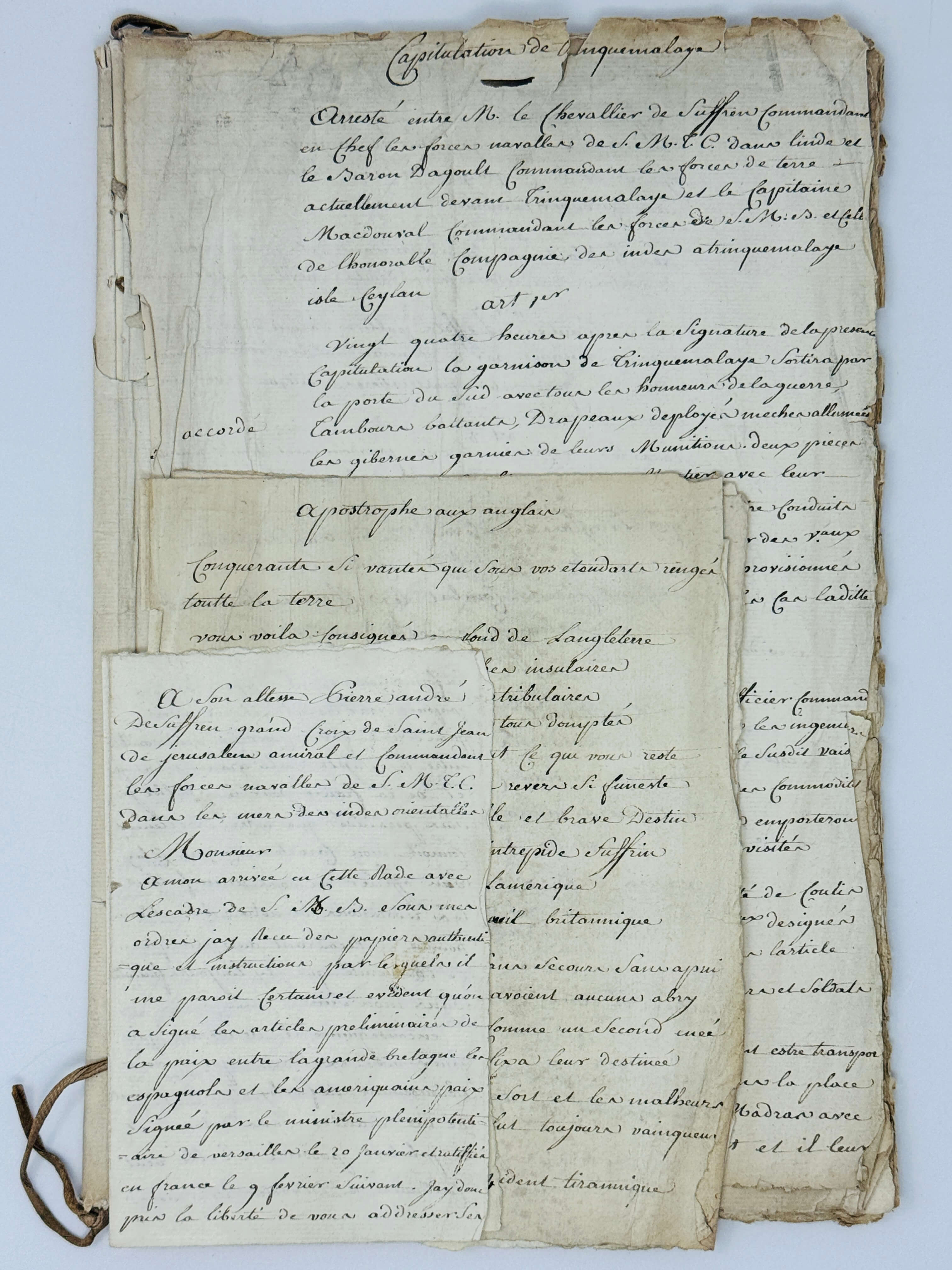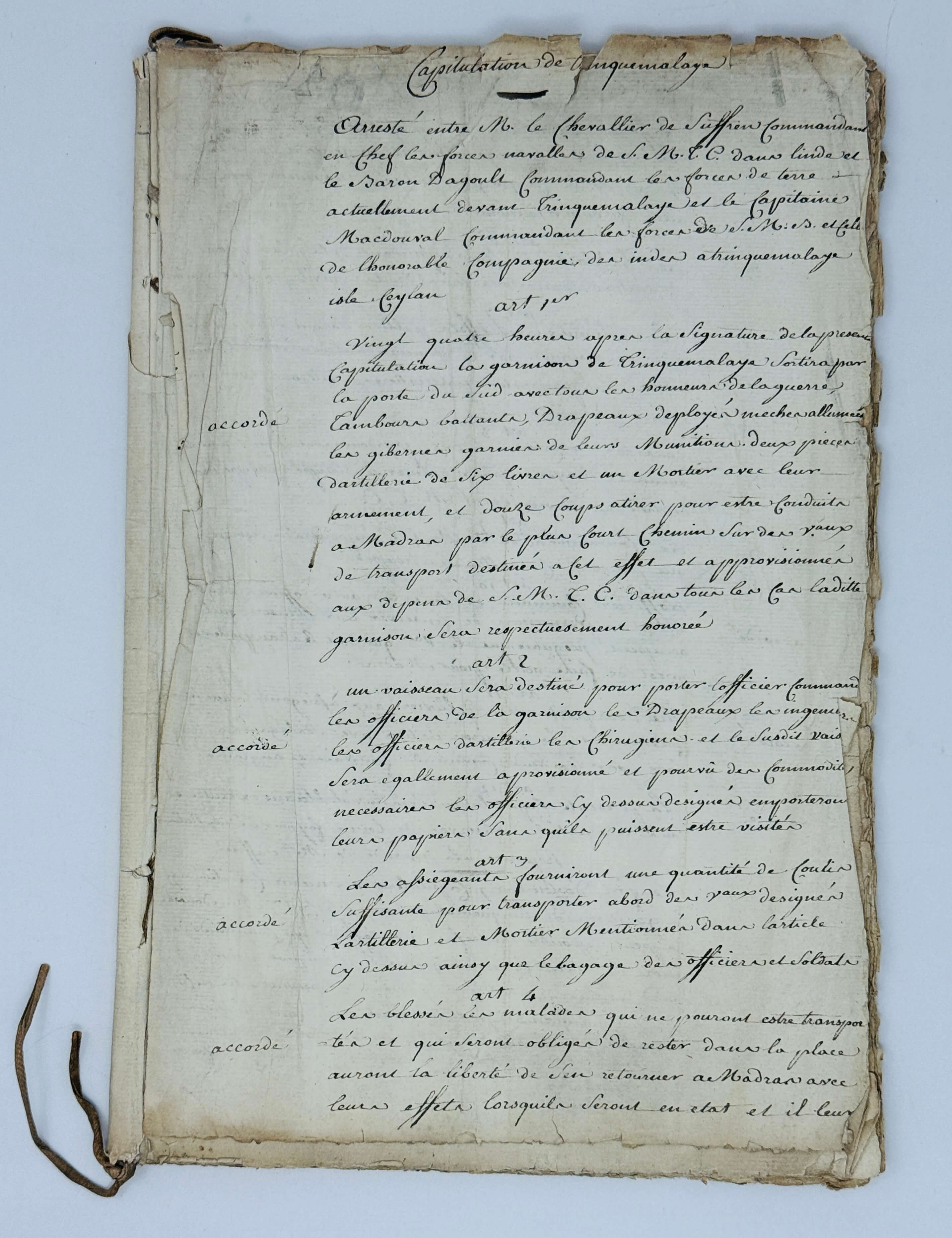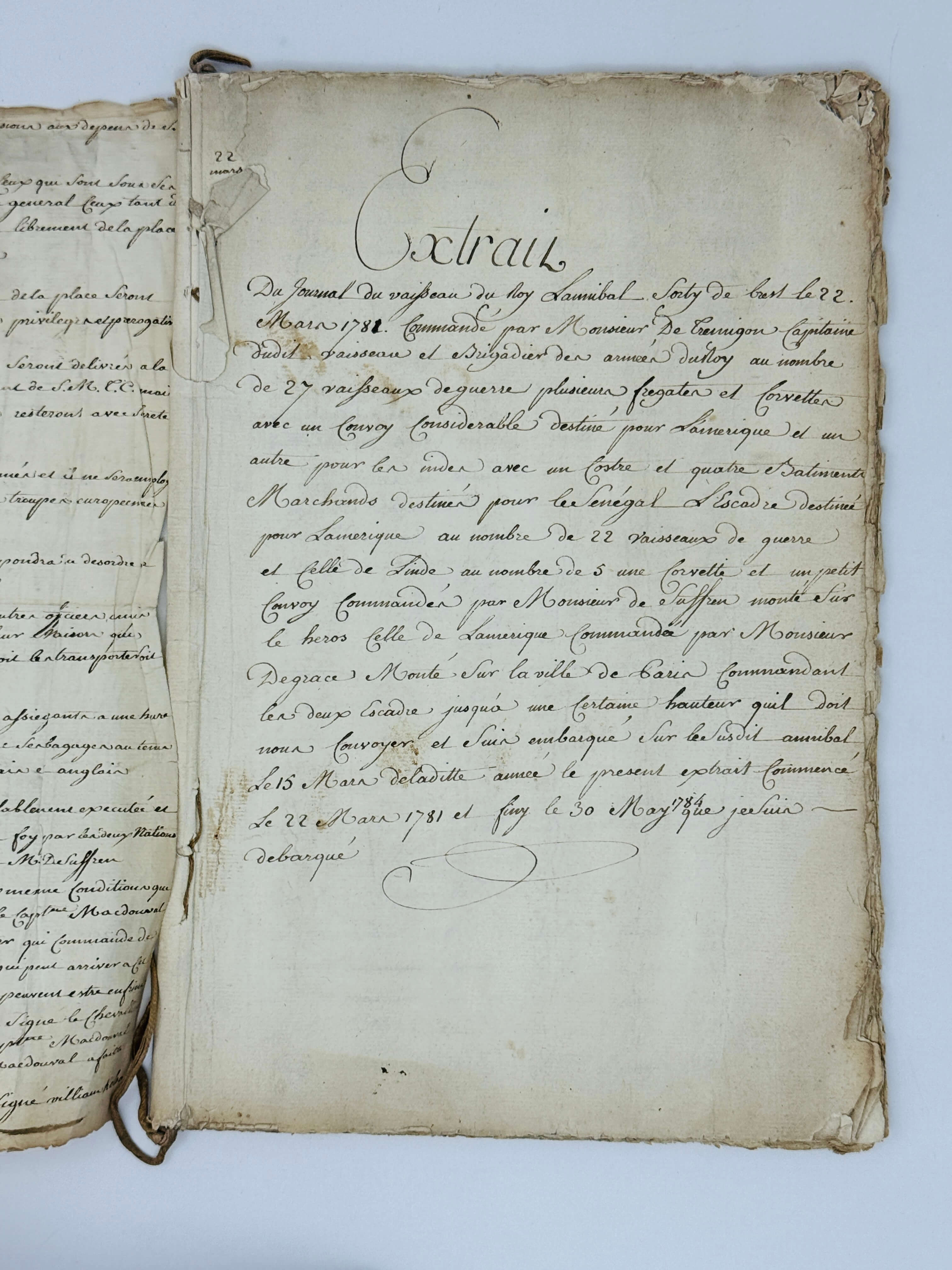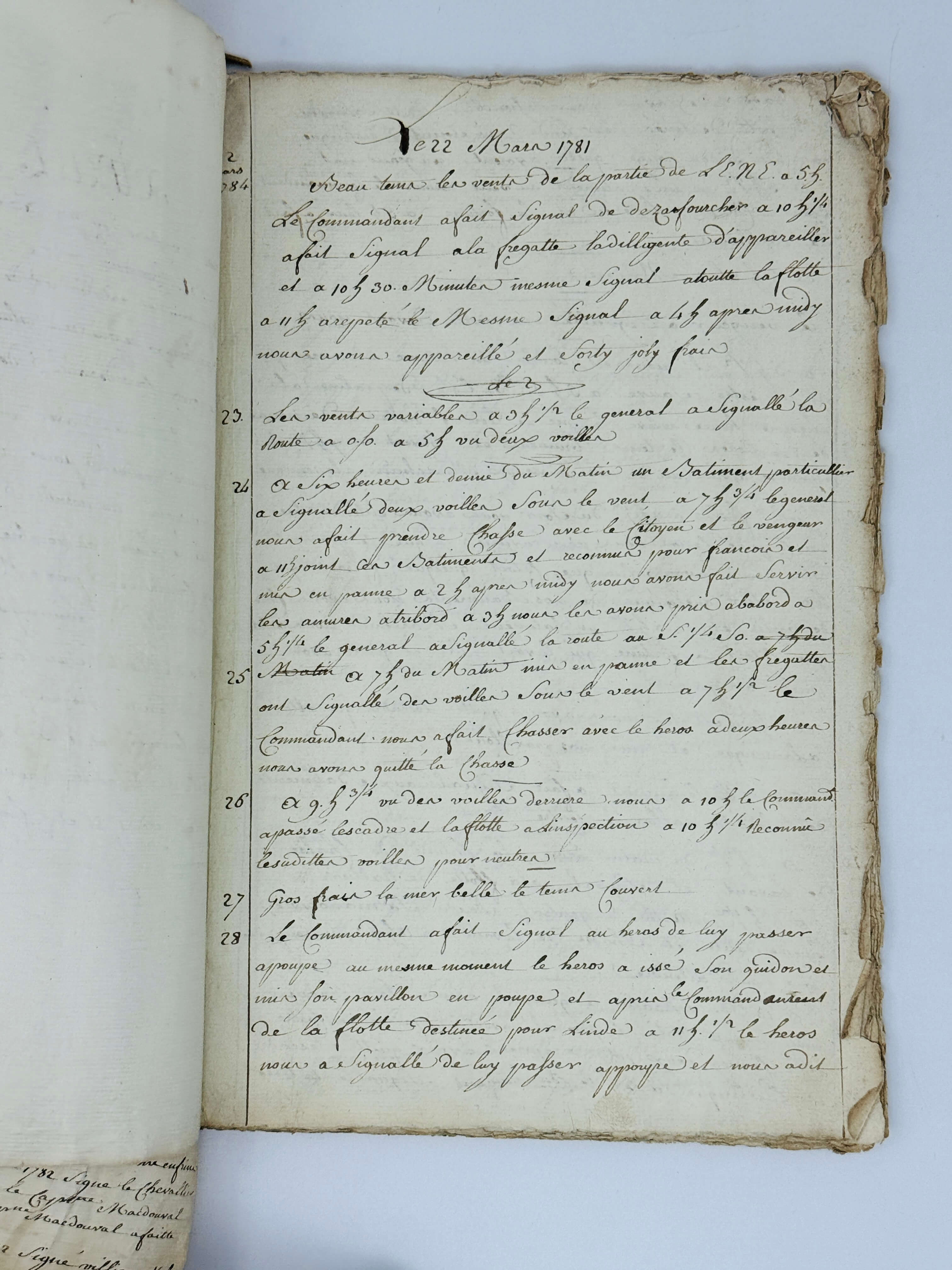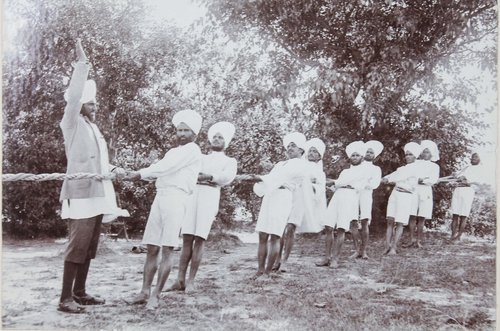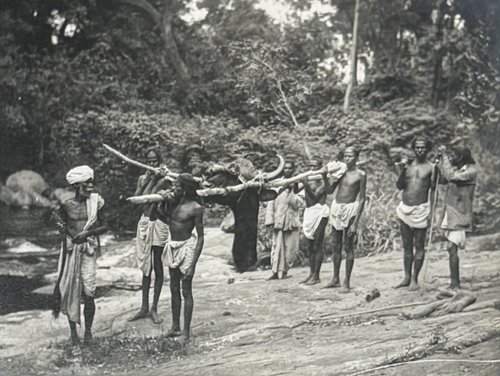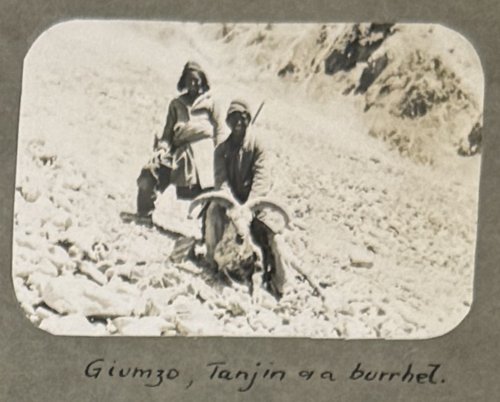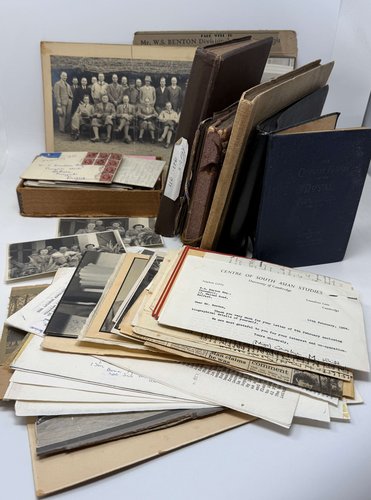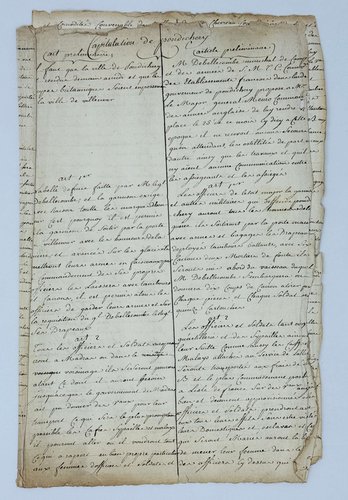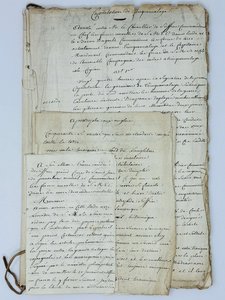
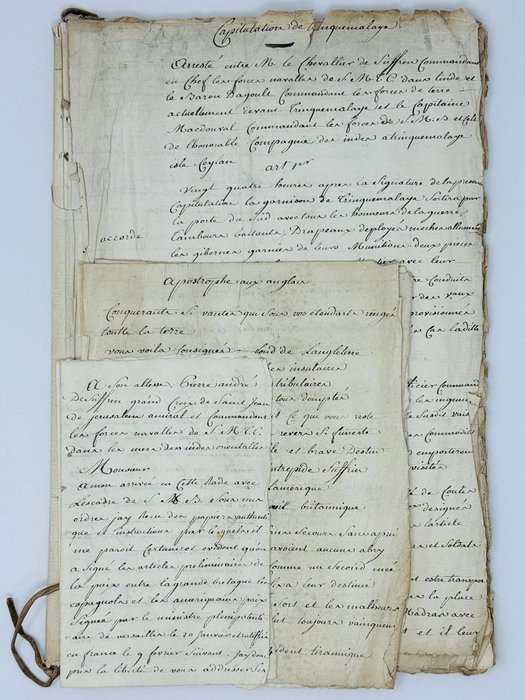
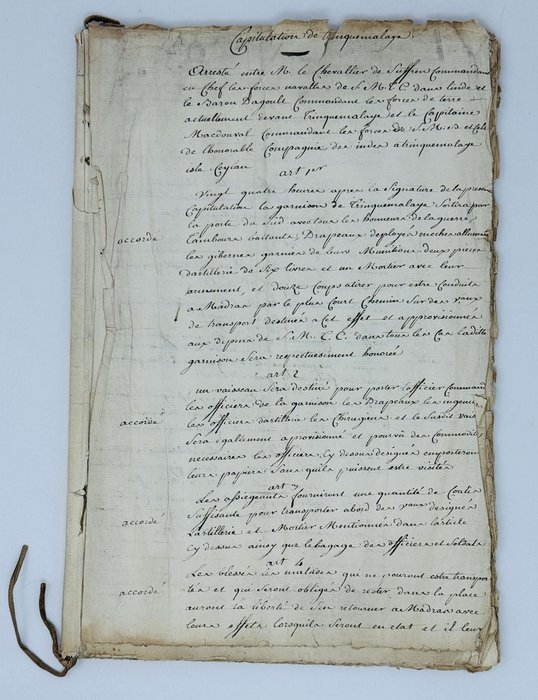
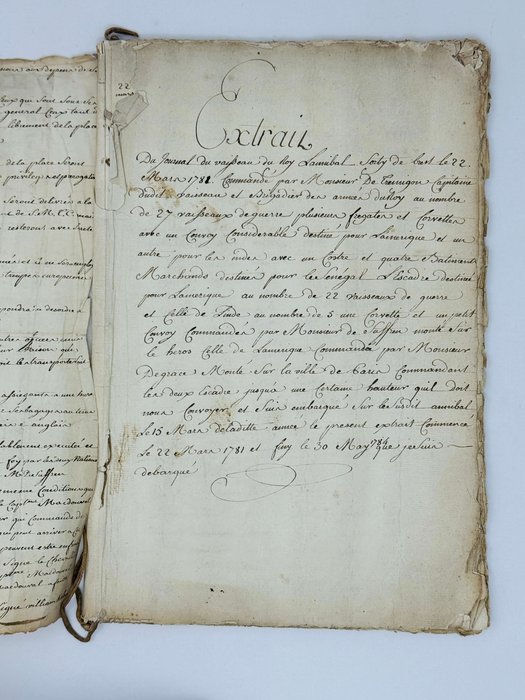
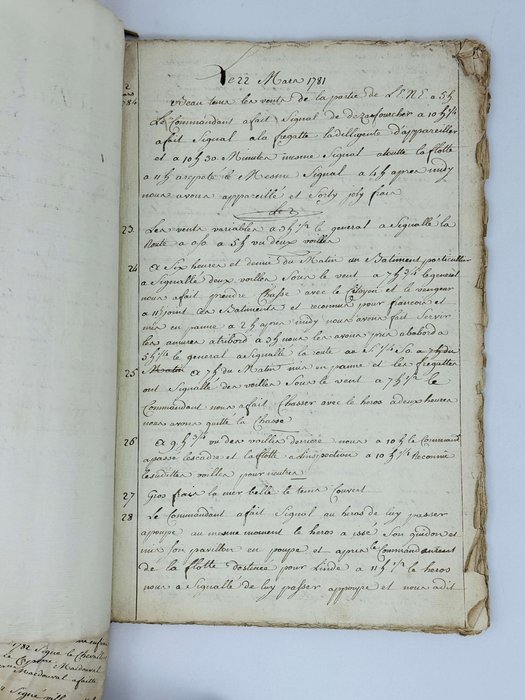
#MD21
Ca. 1781-1785
Ship's Journal: Folio (ca. 32 x 21 cm or 12 ½ x 8 ¼ in). [1 – t.p., 56] pp. Black and brown ink on creamy watermarked laid paper. Paper slightly age-toned, occasional creases, tears and losses on extremities, but overall a very good manuscript.
With five original manuscripts from Folio (ca. 32 x 21 or 12 ½ x 8 ¼ in) to 16mo (ca. 16 x 10 cm or 6 ¼ x 4 in). Brown ink on creamy watermarked laid paper, in all 18 pp. Paper slightly aged-toned, occasional creases, tears and losses on extremities, but overall very good manuscripts.
A historically significant archive of original manuscripts and period copies relating to French naval and land engagements on the east coast of India and the Cape Verde Islands between 1781 and 1783, led by Vice-Admiral Pierre André de Suffren (1729-1788) as part of the 1778-1783 Anglo-French War.
The Anglo-French War (also called the War of 1778 or the Bourbon War) was a conflict fought between Britain and France in several theatres, including in the Caribbean Sea, the Mediterranean Sea, and the Indian Ocean. Parts of the war were also fought in North America, as France backed American independence. Between 1782 and 1783, the East Indies (Indian Ocean) saw combat as Suffren fought a series of naval battles against British Admiral Sir Edward Hughes (ca. 1720-1794), in order to cut Britian off from its Indian resources. Fighting stopped in 1783, shortly after the Battle of Cuddalore, when France and Britian signed a peace treaty. Both countries returned nearly all territories acquired during the war, however, the high costs of the war for France would ultimately lead to the French Revolution (1789-1799).
Pierre André de Suffren was a French naval officer. He began his career in 1744 during the War of the Austrian Succession (1740-1748) and was made a lieutenant during the Seven Years’ War (1756-1763). After leading a division as part of France’s participation in the American Revolutionary War (1775-1783), he was appointed leader of a squadron in 1781 and sent to the Indian Ocean under Thomas d’Estienne d’Orves (1727-1782). After the death of d’Orves, Suffren took command of the fleet. After the war, a fourth vice-admiral position in the French Navy was created especially for Suffren. He died shortly before being sent to command the Brest squadron once more in 1788.
The largest document in the archive is a 56-page period manuscript copy of an excerpt of the journal of the Annibal, a French naval ship launched in 1778. In 1781, after participating in the West Indies theatre of the American Revolutionary War, it was sent to the East Indies as part of the squadron led by Suffren. Annibal departed Brest (France) captained by Achille de Trémignon (1732-1781). The logs are dated between 22 May 1781 and 29 May 1784, as it departed and returned to Brest, respectively.
The journal covers several battles from the East Indies theatre of the Anglo-French War (1778-1783), including the Battle of Porto Praya (Cape Verde Islands, 16 April 1781), where the ship’s captain Trémignon was killed and a series of battles fought between the French fleet led by Suffren and a British fleet led by Admiral Sir Edward Hughes (ca.1720-1794): the battles of Sadras (17 February 1782), Providein (12 April 1782), Negapatam (6 July 1782),) and Cuddalore (20 June 1783), as well as the capture and subsequent naval battle of Trincomalee (25-30 August & 3 September 1782). The descriptions of the battles include the manoeuvres conducted and signals sent between ships.
The journal also covers other notable events. They include Annibal’s departure from Brest as part of a 5-ship squadron; the ship’s stay at the Cape of Good Hope (South Africa) between 20 June and 3 September 1871, where the sick and wounded (from the battle of Porto Praya) were disembarked; its stopover on the Isle of France (now Mauritius) between 26 November and 6 December 1871; the fusion of Suffren’s squadron with that of Admiral Thomas d’Estienne d’Orves, who took command and departed the Isle of France on 7 December 1781; the seizure of the British naval ship Hannibal (“Annibal”), at the time en route from Europe to Madras (Chennai, India) and captained by “M. Cristy,” on 22 January 1782; the ship’s arrival to the Coromandel Coast (southeastern coast of India) and the subsequent death of d’Orves on 5 and 8 February 1782, respectively, where command of the squadron was then given to Suffren; wintering in “Dachin” (Aceh, Sumatra, Indonesia) between 4 November 1782 and 19 December 1782, where the squadron was forbidden from sending any boats to shore on 15, 16, and 17 November, as the “Dachin King” (possibly Sultan Alauddin Muhammad Syah; ca. 1760-1795, r. 1781-1795) was having a celebration; and the seizure of the British frigate Coventry on 12 January 1783.
Excerpts from the journal (spelling original):
“[16 April 1781, Porto Praya:] … A la mesme heure le gl a fait signal de former la ligne de bataille <…> nous avons vu les ennemis au nombre de cinq vaisseaux de guerre quatre frigates un Brulot et trente six batiments marchands <…> dans le combat nous… avons eu 60 hommes de tuer sur le coup et 200 blesseurs graves comme bras et jambes couper et autre blesseurs, nous avons perdu M. Detremignon capitaine dudit vaisseau”
“[24 June 1781, Cape of Good Hope:] Nous avons mis nos maladies a terre et le reste de nos blesses qui etoient rester en tres petit nombre…”
“[18 October 1781, Indian Ocean:] A 5h ½ nous avons vu une eclipsse de soleil qui a duré jusquá trois heures vingt minutes.”
“[22 January 1782, Indian Ocean:] … cequi nous a fait presumer que nos vaisseaux se trouvoient asser pres du chassé pour le combat avec avantage cette petite canonade a duré une demie heure… a 10 h ½ le canot est venu abord avec un officier qui nous a dit que la prise etoit de 54 canons nommée l’Annibal [Hannibal] de 350 hommes d’equipage venant d’europe allant a Madras commandé par M. Cristy capitaine du vaisseau.”
“[8 February 1782, Coromandel Coast, Indian Ocean:] … anoncer a lescadre que le general (M. Dorve) [D’Orve] etoit Mort. A 5 h ½ du jour notre nouveau general (M. DeSuffren) a fait signal d’ordre…”
“[12 Novembre 1783, Aceh, Sumatra:] A 8h ¾ Signal d’ordre pour deffendre a tous les vaisseaux d’envoyer aucuns canots a tere le 15, le 16, et 17 pour la raison que le Roy Dachin celebroit sa feste, il son ordinairement cinq jours mais il nous demandé que trois.”
There are also four additional manuscript documents. They include a copy of a document titled “Capitulation [Treaty] de Trinquemalaye [Trincomalee]” signed by Suffren and Captains “Macdouval” (Hay MacDowell, ca. 1759-1809) and “Kelso,” the commanders of the forts of Trincomalee and Ostenburg respectively, and dated 30 & 31 August 1782; a table titled “Escadres francaise et anglaise qui se sont combattues le 20 juin 1783 à vue de Goudelour [French and English squadrons that fought on 20 June 1783 near Cuddalore];” a copy of a letter from an “Admiral Yousse” to Suffren regarding peace negotiations of the Anglo-French War dated 25 June 1784; and a poem written in honour of Suffren and his victories over the British titled “Apostrophe aux anglais.”
Excerpts from the documents (spelling original):
(Letter) “Jay recu des papiers authentique et instructions [par?] lequels il me [paroit?] certain et evident qu’on a signé les articles preliminaires de la paix entre la grande bretaque les espagnols et les ameriquains…”
(Poem) “Vu petit coin du monde est tout ce qui vous reste qui peut vous accabler d’un revers si [funeste?] cest vous heros fameux noble et brave Destin et vous son digne emulle intrepide Suffren Sous vos foudres L’asie et L’amerique ont vu tomber enfin […?] britannique”
(Treaty) “Reponse a la demande de M. DeSuffren. Le fort d’ostenbourg capitulera aux meme conditions que la garrison de trinquemalaye mais le Capitaine Macdouval ne peut repondre au au [refas?] que l’officier qui commande de rendre la place et enconsequence de ce qui peut arriver a cet egard aucun des articles cy dessus ne peuvent etre enfrime.”
Overall, an interesting, original, and content-rich archive providing information on battles between France and Britain over their Indian possessions in the late 18th century.

